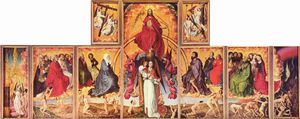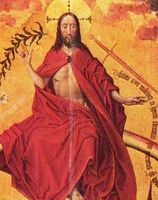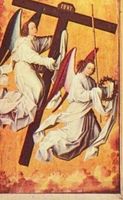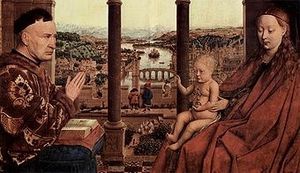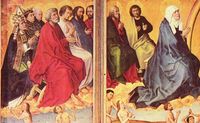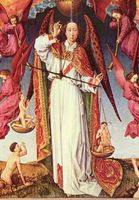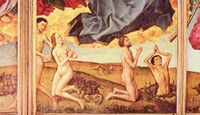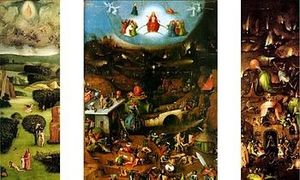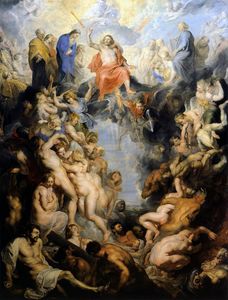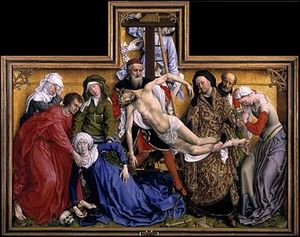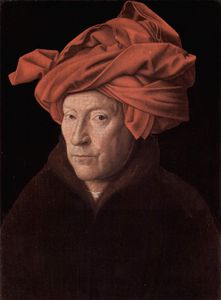Altarpiece of the Last Judgement
- Date of Creation:
- circa 1452
- Alternative Names:
- The Last Judgment
- Height (cm):
- 214.00
- Length (cm):
- 560.00
- Medium:
- Oil
- Support:
- Wood
- Subject:
- Figure
- Art Movement:
- Renaissance
- Commissioned by:
- Nicolas Rolin
- Created by:
- Altarpiece of the Last Judgement Page's Content
- Story / Theme
- Inspirations for the Work
- Analysis
- Related Paintings
- Locations Through Time - Notable Sales
- Artist
- Bibliography
Altarpiece of the Last Judgement Story / Theme
The Last Judgment in Christianity:
In the Christian tradition the last judgment - commonly known as Judgment Day - marks the end of time and, as its name suggests, the time when all souls, both living and dead, will be judged by God (or Jesus Christ).
On this day, the faithful believe that God will pass final judgment over the souls of all humans, assigning them to either eternal excruciation or eternal bliss. According to the Bible, in Matthew 13: 40-43, all evil-doers will be thrown "into the furnace of fire, where there will be weeping and gnashing of teeth," while the righteous "will shine like the sun in the kingdom of their Father. "
At the time Rogier van der Weyden painted this image, the view sponsored by the Catholic Church was nearly universally held by Christians. It holds that when Jesus Christ returns to Earth, the dead will be resurrected and reunited with their bodies and each person will be judged for a final time.
Those who are already in heaven will remain there; those that are already in hell will remain there; and those who are in purgatory will finally be released into heaven. Those people who are still living when Christ returns will be judged and sent to their determined place. It is believed that after this Final Judgment, the universe will be renewed, paving the way for a rebirth of earth and heaven.
Altarpiece of the Last Judgement Inspirations for the Work
Commission:
Altarpiece of the Last Judgement was commissioned in 1452 by the Chancellor Nicolas Rolin of Burgundy and his third wife, the remarkably devout Guigonne de Salins.
While the chancellor and his wife were obscenely wealthy, they were also concerned with contributing to the salvation of their souls by performing charitable acts on earth. Nine years earlier, in 1443, they founded the Hospices de Beaune, a charitable house for Burgundy's many poor and sickly citizens.
When the Hospice de Beaune first opened its doors to the destitute, elderly, disabled, orphaned and heavily pregnant, it contained a chapel where those seeking refuge could pray and enjoy communion with their creator. At the front of the chapel, behind the altar, one of Rogier van der Weyden's masterpieces could be found.
Religious devotion:
While van der Weyden may not have chosen the theme of the painting, there is little doubt that his own religious beliefs contributed to the work's completion. Van der Weyden was apparently a very pious man who headed a very pious household - his eldest son even became a Carthusian monk. It is no wonder, then, that the Altarpiece of the Last Judgement is such an intricate and evocative display since the artist was able to inject a religious fervor to his work.
Altarpiece of the Last Judgement Analysis
Composition:
Van der Weyden designed this painting to have a two-tiered composition, with a top part - comprising the majority of the panel space - representing heaven and the bottom part showing earth.
Heaven is depicted as a cloud of gold, upon which are seated the apostles, a pope, a bishop, and king, a monk, three female saints and the Virgin Mary and St. John the Baptist toward the center where the archangel Michael holds a scale, positioned below Jesus Christ. From heaven, these holy people are able to see the events transpiring below them where the figures take on a much smaller scale to differentiate mere human from the saints.
On earth, the humans are seen bursting forth from the earth - the resurrection of the dead - and being shuffled either to the left or right. Naked, each human is propelled toward their fate - either salvation (complete with golden gates and blue skies) to the right - or damnation (shown as a gaping, fiery pit) to the left.
Mood, tone and emotion:
A painting with so many subjects such as this one might have caused a different artist to break out the expressionless, stock faces, but Rogier van der Weyden seems to have relished this opportunity to create a multitude of features and emotions.
The faces of those humans who are saved, though similar, are certainly different. While a few of them seem to plead worriedly with the heavens, others offer explicit thanks and appear happy. One man is seen assisting a woman who's face is turned thankfully toward her judges while another women, already at the gates of heaven, peers over her shoulder suspiciously, with an inkling of worry or guilt.
Meanwhile, the expressions of the saints in heaven range from pensive and adoring to sympathetic and disdainful.
Altarpiece of the Last Judgement Related Paintings
Altarpiece of the Last Judgement Locations Through Time - Notable Sales
This masterpiece has been located in the same place - the Hospices de Beaune - since its completion more than five hundred years ago. Although it used to be housed directly in the chapel, its original home, it has been moved to an adjoining, temperature-controlled room to protect the work from further deterioration.
Altarpiece of the Last Judgement Artist
Rogier van der Weyden began tasted success very early in his career. He was seen as an innovative painter, with a fresh vision and acute sense of emotion - qualities often devoid in artists during a time when formulaic religious depictions were widespread.
Artists in his workshop reprinted and imitated his works for dissemination throughout Europe. What his contemporary imitators and students could not convincingly replicate, however, was the same subtlety and 'contempt for mere representation' that van der Weyden so effortlessly achieved.
Rogier van der Weyden was remembered during the 16th and 17th centuries as a well-respected artist and man and people still marveled at his unique interpretations and subtly emotive subjects.
During the 18th century, van der Weyden's name and works were all but forgotten after his most accessible and impressive work, Scenes of Justice, was destroyed in 1695. By the 19th century, however, art historians began the arduous task of piecing together the shreds of his biography and oeuvre, wading through confusing double-biographies, rediscovering manuscripts and records and attributing paintings.
Today, Rogier van der Weyden is regarded as one of the pre-eminent painters of the Early Netherlandish style, lauded for his introduction of masterfully subtle emotions. He enjoys a place in art history books alongside more well-known painters like Jan van Eyck, though his own accomplishments are unrivaled.
Altarpiece of the Last Judgement Bibliography
For further insight into the works of Rogier van der Weyden, please refer to the following recommended sources.
• Campbell, Lorne. Van Der Weyden. Chaucer Press, 2004
• Campbell, L. & Van Der Stock, J. Rogier Van Der Weyden 1400-1464: Master of Passions. Waanders BV, Uitgeverij, 2009
• de Vos, Dirk. Rogier Van der Weyden: The Complete Works. Harry N. Abrams, 1999
• Kemperdick, Stephan. Rogier van der Weyden: 1399/1400-1464 (Masters of Netherlandish Art). H. F. Ullmann, 2008
• Pacht, Otto. Early Netherlandish Painting from Rogier van der Weyden to Gerard David. Harvey Miller Publishers, 1997
• Ridderbos, Bernhard, et al. Early Netherlandish Paintings: Rediscovery, Reception, and Research. J. Paul Getty Museum, 2005

